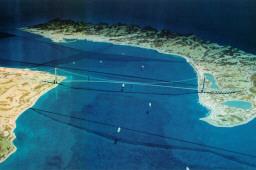A total of 40,000 people will be employed in the proposed building of a bridge across the Messina Strait, linking Sicily to the mainland, Public Works Minister Altero Matteoli said on Friday.
Had the government's economic committee CIPE last month not approved some 17.8 billion euros in funds for a package of infrastructure projects, including the bridge, ''we would have lost 65,000 jobs. But thanks to the package we will have 140,000 more jobs,'' he added.
Aside from the Messina bridge, the 17.8 billion euros will be used for the construction or completion of various key motorways, including links in northern Italy and a long-delayed highway extension between Salerno and Reggio Calabria, building new schools and prisons and key infrastructures for the Milan 2015 World's Fair.
The Messina bridge project was originally presented by Premier Silvio Berlusconi's 2001-2006 government, when it had been a key campaign promise in the 2001 general election, but was later shelved during the two-year centre-left government headed by Romano Prodi.
According to Prodi's transport minister, Alessandro Bianchi, the multi-billion-euro project, was ''the most useless and damaging project in Italy in the last 100 years''.
However, during his successful election campaign last spring, Berlusconi renewed his pledge to build the bridge. The Messina bridge, which once built would be the longest suspension bridge in the world, has been hailed by Berlusconi's government as a huge job-creation scheme that would give Italy's image a major boost while bringing Sicily closer to the mainland in both physical and social terms.
But it has been opposed by environmentalists and dogged by concerns over its safety and fears of potential Mafia involvement.
When and if completed, the bridge would replace slow ferry services between Sicily and the mainland.
The 3,690-metre-long bridge has been designed to handle 4,500 cars an hour and 200 trains a day.
Work on the 6.5-billion-euro structure was originally scheduled to start in late 2006 and end in 2012.
Current estimates are for getting construction started in mid-2010 and completing the bridge in 2016.








